By Admire Mare
Since the signing of the historic Windhoek Declaration 30 years ago, the media in Africa has undergone transformative changes at various levels including, production, distribution, consumption and business model. These changes have shifted journalistic practice significantly and recalibrated the ways in which audiences interact with news content.
This oft-cited ‘revolutionary’ process, which began to take shape in the 1990s, has been accompanied by rapid integration of digital media technologies into the newsroom, at a broader level and into the news making process at a very specific level. In fact, when the Declaration was ratified, analogue was the dominant way of news transmission.
At that time, computers were still a distant dream. Mobile phones were not yet a reality then. Websites were just beginning to find their way into the operations of organisations. Blogs were not in vogue. Social media was not even part of the popular lexicon. News was predominantly consumed via newspapers, radio, television, and magazines.
Starting with the slow but impactful domestication of the mobile phone and short message services in the late 1990s, the media in Africa have gone down and under in their quest to broaden and diversify toolkits necessary for news production and distribution. They also moved with speed to digitise news distribution through launching attractive websites and mobi-sites.
Some media organisations have launched value-added services structured around the SMS. At the height of the popularity of the mobile phone as a status symbol and communicative device, SMS-based news and information alerts are driving services such as breaking news, news headlines, sports fixtures and scores. While notifications on stock prices, weather, traffic and horoscopes also became the norm.
Adoption and Innovation
Despite Africa being one of the least connected places on earth, the media have adapted and innovated around these structural challenges. Surprisingly, it’s the mobile phone that is credited for transforming the practice of journalism in Africa. The mobile phone has been harnessed in ways that have forced scholars to rethink the concept of the digital divide. It has enabled journalists, editors and audiences to interact and collaborate in the news making processes in complex but interesting ways.
In most African newsrooms, the so-called ‘digital revolution’ has disrupted the status quo to an extent that journalists and media managers have been forced to adapt to new processes of story-telling and to rethink business strategies in order to remain competitive. Others have introduced multimedia content as a way of ‘following’ their audiences who are increasingly migrating online in search of diverse, personalised and ‘free’ lunch.
Many media organisations in Africa have experimented with mobile and digital first strategies, ultimately creatively integrating social media platforms into the news making cycle. These innovative strategies included breaking news being published online first before it is eventually repurposed for ‘Day 2 journalism’. While some have managed to monetise their online media products, taming the online jungle has been found to be a difficult goal.
Studies across African newsrooms, have shown adopted digital technologies, particularly mobile phones, social media platforms and wireless Internet as instruments through which newsrooms can quickly collect, package, and disseminate information. Thus, digital media technologies’ inherent properties have presented unprecedented flexibility in the professional communicative practices of editors and journalists in African newsrooms.
Instead of continuing with a business as usual approach, other organisations have recruited online/digital media editors particularly with ‘taming the online jungle’ and packaging multimedia content for a ‘global’ audience. The recruitment of multimedia journalists in newsrooms was initially met with resistance as the ‘old guard’ fought tooth and nail to preserve the status quo. Even the shift from the typewriter to the modern computer was not easy to effect in most African newsrooms.
As a result, since the early 2000s, the media ecology in Africa has undergone seismic changes. Gone are the days where news-making processes were dominated by manual processes. With audiences preferring to consume media products in digital formats, media organisations in Africa have had to introduce mobile news, social media updates, online newspapers, Facebook live broadcasting and Twitter news bites. For instance, news organisations such as Nation Media Group (Kenya), Mail and Guardian (SA & Zimbabwe), Media 24 (South Africa), Alpha Media Holdings (Zimbabwe) and others have led the way in coming up with innovative digital strategies and products.
‘Analytic turn’ in Journalism
The realisation that online content would cater for a global audience has forced media organisations to shift from ‘hyperlocal’ news towards content that could attract clicks, views, shares and retweets by global citizens in an increasingly interconnected world.
In most cases, media organisations in Africa began to package news that would ‘interest the public’ rather than serve the ‘public interest’.
Buoyed by the strategic use of editorial analytics and metrics, online or digital media editors in African newsrooms have started to religiously monitor and evaluate the performance of their online stories. This ‘analytic turn’ in newsrooms meant that news as an industrial product became measurable and quantifiable.
In some news organisations, these measurement techniques have transformed the ways in which journalists understand their audiences and assess the performance of their content.
Besides measuring the performance of news stories, these technological strategies have been utilized to monitor and evaluate reader engagement, hence helping shape the next content. In this era of ‘participatory journalism’, audiences have become part of the news making cycle rather than simple end- users waiting for a ‘product’ produced and packaged by journalists.
Thus, user-generated content has become an integral part of modern newsrooms as eyewitness accounts and citizen journalists output complement news articles produced by professional journalists.
Analytic tools like Chartbeat, Orphan and Lantern have been instrumental in the measurement of site visits or page views, depth of scroll, time spent on page, traffic source and device breakdown. This feeds into the overall company-wide engagement metrics that measure the frequency of visits, time spent reading, and the volume of articles read. They also enable news organisations to engage in digital listening, monitoring, and strategy refinement.
The digital divide and audiences
Although the creative appropriation of technologies in African newsrooms have opened up new spaces for news production and distribution, it is important to note that the issue of the digital divide continues to affect online news consumption. Many of those with access to digital media technologies, devices and data are based in urban areas and the diaspora. This means that those in the rural areas are still very underserved by online news outlets, a scenario which pushes them back to rely on radio as a key source of news and information. Furthermore, lack of access to reliable electricity, weak network signals and limited financial muscle skews online news consumption in favour of those who are connected to the Internet.
In the past, mobile news services through short message services (SMS) have proved effective in reaching the rural areas. However, the slow death of the SMS, has seen media organisations shifting their attention to website and social media updates. In some contexts, WhatsApp and TikTok now provide an important outlet to distribute online news.
However, the big challenge still remains, which is related to how to monetise content distributed through mobile instant messaging sites. Be that as it may, a silver lining is that; at the height of the fast-spreading coronavirus pandemic, media organisations in Africa have scaled up their distribution of PDF versions of their newspapers through WhatsApp, emails and specific online apps like Flip.
While these innovative distribution mechanisms have assisted some African media organizations to grow their online audiences, it is too early to conclude in terms of their impact on monetization strategies.
Given the uneven socio-economic development in Africa, access to information and news remains a key challenge for people living in underserved communities such as rural areas and most urban periphery. These communities do not have access, not only to online news portals but are also largely cut off from traditional media channels such as newspapers, radio and television. With their urban and youthful audiences changing the ways of consuming information, the media in Africa have attempted to keep pace with the changes, although this shift to online platforms further exacerbated the uneven access to information and news between those in urban and rural areas.
Looking into the future
It is clear that the media ecology in Africa has changed over the last 30 years. Whilst the issues of press freedom and safety of journalists remain precarious in some jurisdictions, the best way to sum up the situation is to use the “glass full, glass half empty” metaphor.
Over the past three decades, media in Africa have harnessed the full potential of digital media technologies even though most of them are still struggling to address the financial sustainability issues that have accompanied the ‘digital revolution’. The migration from offline to online publications has not necessarily been accompanied by financial rewards.
Advertisers have been reluctant to follow media audiences online thereby paralysing the operations of some media organisations. In cases, where advertisers have embraced online ads, they have chosen to advertise with Facebook, Google, Twitter, YouTube and other big platform companies directly. This has complicated the business models of most African media organisations.
With Internet and social media penetration rates continuing to improve in Africa, there is hope for retaining and growing audiences willing to consume content online. The big question however is: how do the media organisations on the continent harness these people into monetisable audiences? An answer to this pertinent question will require thinking outside the box. Cutting and pasting models from the global North might not necessarily work because of the different socio-economic and cultural factors at play. Media managers ought to know their audiences, preferences, demographics, lifestyles and socio-economic statuses in order to produce and distribute relevant content.
Media audiences are no longer an afterthought in the news making cycle, they have become a crucial cog in the news production equation that ought to be consulted, listened to and allowed to participate through various invented and invited spaces of news engagement like readers comment section, social media accounts, tweets and comments. With the uptake of digital technologies having been escalated by the coronavirus global pandemic, it is up to media organizations in Africa to find relevant, context-specific and appropriate mechanisms to build productive and rewarding relationships with their audiences.
Admire Mare is an Associate Professor and Deputy Head in the Department of Communication at the Namibia University of Science and Technology, Windhoek, Namibia. He is also a Senior Research Associate at the University of Johannesburg’s Faculty of Humanities. His research interests include analyzing the complex intersection between technology and society, digital journalism, social media and politics, media and democracy, media and conflict and the role of artificial intelligence in newsrooms. He currently leads the international research project ‘Social Media, Misinformation and Elections in Kenya and Zimbabwe’ (SoMeKeZi) funded by the Social Science Research Council (2019-2021). He is also the co-author of ‘Participatory Journalism in Africa Digital News Engagement and User Agency in the South’ (New York: Routledge, 2021 with Hayes Mawindi Mabweazara). He is also the co-editor of ‘Media, Conflict and Peacebuilding in Africa: Empirical and Conceptual Considerations’ (London: Routledge, 2021 with Jacinta Maweu). Email address: admiremare@gmail.com


